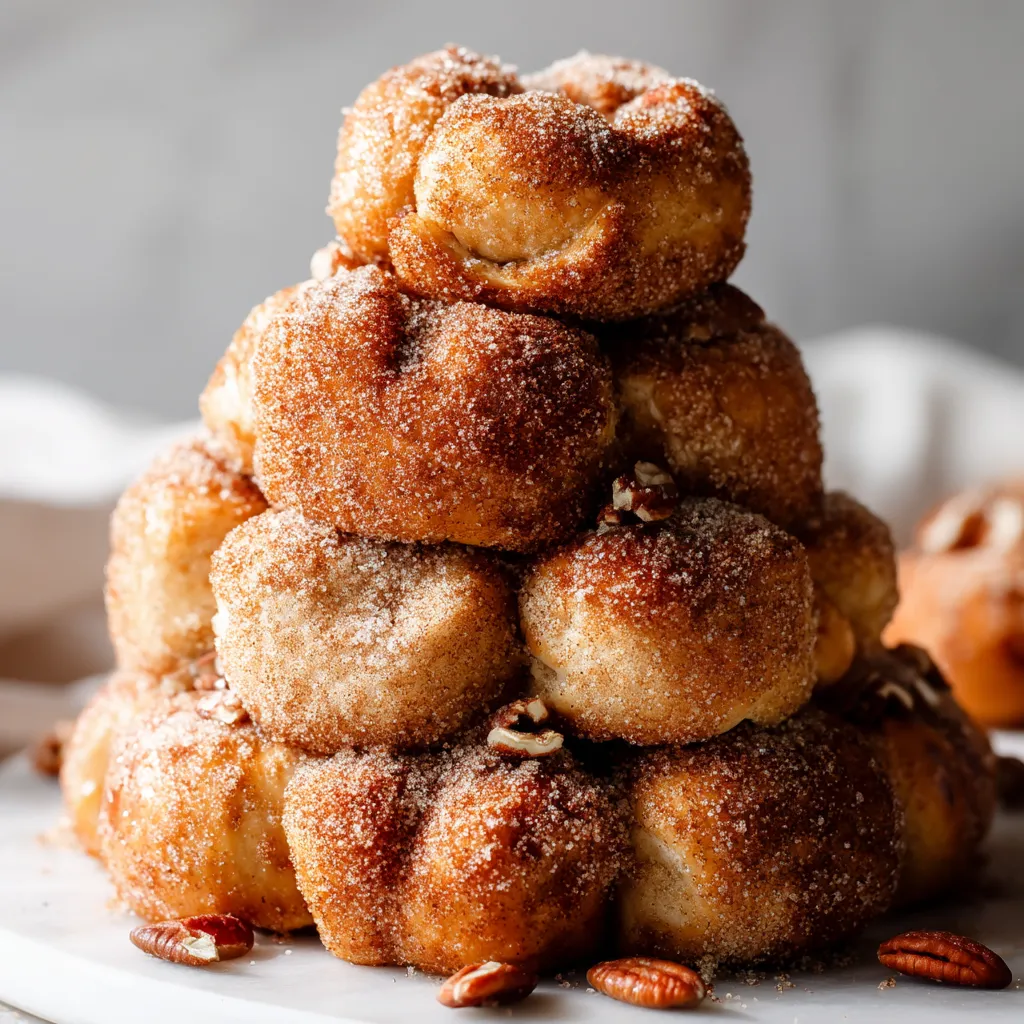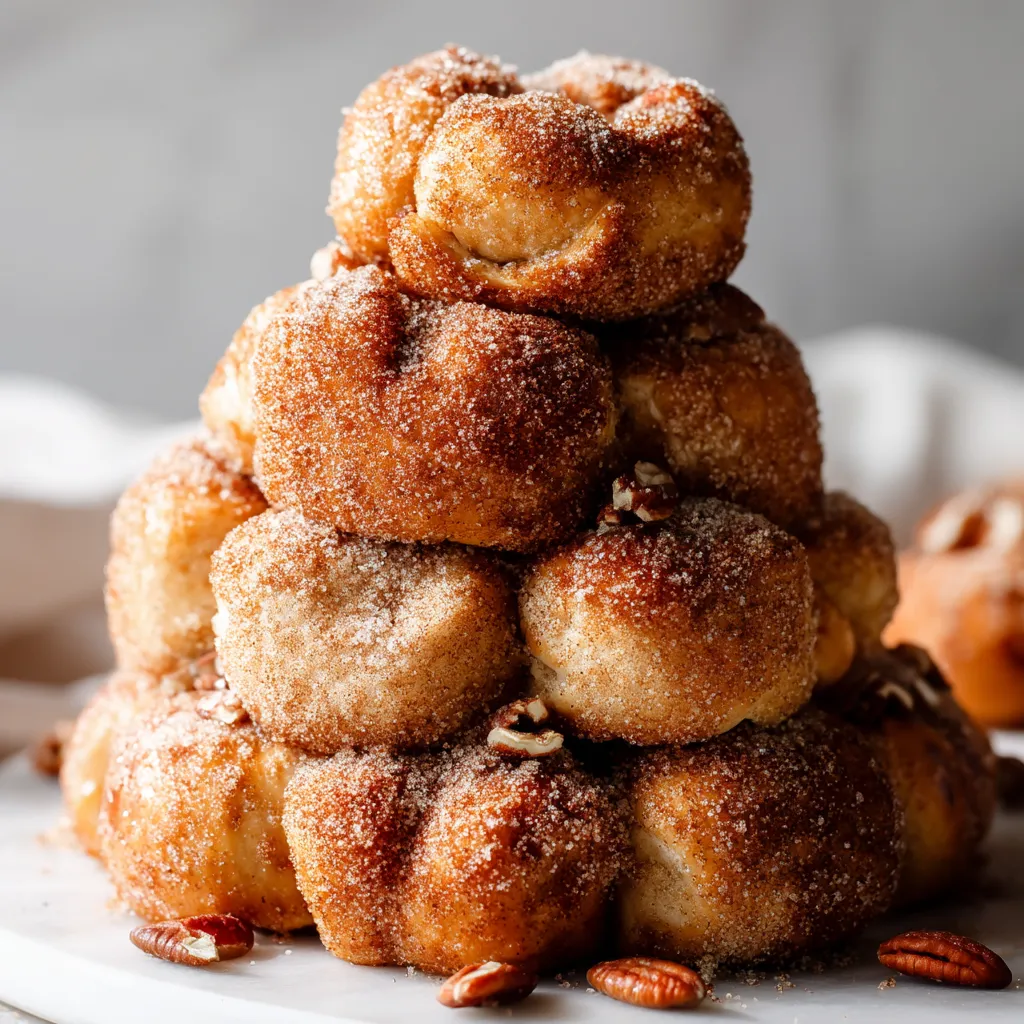 Mark
Mark
This high-protein monkey bread transforms a traditionally indulgent treat into a nutritious delight that won't spike your blood sugar. The best part? No yeast or rising time needed, making this a quick solution when you're craving something sweet but don't want to derail your nutrition goals.
I developed this recipe during my fitness journey when I desperately wanted something that tasted like a treat but supported my protein goals. Now it's become my go-to for post-workout breakfasts and the first thing my gym buddies ask me to bring to our meal prep gatherings.
Ingredients
- Flour: Creates the base structure but can be swapped with whole wheat or gluten-free blends for different nutritional profiles
- Vanilla whey-casein protein powder: Adds sweetness and a slow-release protein source for sustained energy
- Unflavored protein powder: Boosts protein content without affecting the flavor balance
- Greek yogurt: Provides moisture and tangy flavor while adding extra protein without the need for oils or butter
- Almond milk: Helps the cinnamon-sugar coating adhere while keeping calories low
- Zero-calorie sugar replacement: Delivers sweetness without affecting blood sugar levels
- Cinnamon: Brings warmth and natural sweetness that makes this taste like a true treat
- Optional pecans: Add crunch and healthy fats that complement the soft texture of the bread balls
Step-by-Step Instructions
- Prepare Your Setup:
- Preheat your oven to exactly 350°F making sure it's fully heated before baking. Lightly butter every surface of your loaf pan including the corners where dough balls might stick. If using pecans sprinkle them evenly creating a single layer that will toast during baking and form a delicious base.
- Mix The Dry Ingredients:
- In a large bowl thoroughly whisk all dry ingredients ensuring no clumps of protein powder remain. This even distribution is crucial for consistent texture. Take extra care to break up any protein powder lumps which can create dry pockets in your finished bread.
- Incorporate The Yogurt:
- Add Greek yogurt to your dry ingredients and fold gently using a spatula or your hands. Stop mixing as soon as shaggy dough clumps form. Overmixing activates gluten making tough chewy balls instead of tender ones. The dough will look slightly undermixed and that's exactly what you want.
- Form Perfect Dough Balls:
- Wet your hands with cool water before portioning and rolling the dough. This prevents sticking and creates a smoother surface. Aim for uniformly sized balls about the size of a golf ball each containing roughly two tablespoons of dough. Rewet your hands between every few balls.
- Create The Coating Magic:
- Pour almond milk into one small bowl and mix cinnamon with sugar replacement in another. The milk creates a thin adhesive layer allowing maximum cinnamon sugar to stick. Work efficiently dipping each ball first in milk then rolling thoroughly in the cinnamon mixture until completely coated.
- Stack Strategically:
- Place your coated dough balls in the loaf pan in irregular layers rather than neat rows. This creates pockets where the flavors concentrate and allows proper air circulation. Leave tiny gaps between some pieces for the classic pull-apart texture that defines monkey bread.
- Perfect Your Baking Approach:
- Bake uncovered initially to develop a slight crust then cover with foil to prevent over-browning while ensuring the center cooks through. The two-stage baking process ensures both proper structure and moisture retention. Your patience during this step determines the final texture quality.

The unflavored protein powder is actually my secret weapon in this recipe. I discovered its importance after making a batch with only vanilla protein powder that came out far too sweet. The balance of flavored and unflavored powder creates the perfect subtle sweetness while maximizing protein content.
Storage Solutions
This monkey bread stays fresh for up to 3 days when stored in an airtight container at room temperature. For longer storage refrigerate for up to 7 days though the texture becomes slightly more dense. To restore the fresh-baked quality microwave individual portions for 15-20 seconds or warm briefly in a 300°F oven until just heated through. Avoid overheating which can make the protein bread tough.
Protein Powder Guidance
The specific protein powders you choose significantly impact your final result. Whey-casein blends work best as they provide both fast and slow-absorbing proteins while contributing to a tender texture. Plant-based alternatives can work but require adjustments typically needing an additional 2-3 tablespoons of moisture per cup of protein powder. Avoid pure collagen powders which lack the binding properties needed for proper structure.
Serving Suggestions
Transform this high-protein treat into a complete breakfast by serving alongside fresh berries and a dollop of Greek yogurt for additional protein and natural sweetness. For post-workout recovery pair with a small banana or apple which provides fast-acting carbohydrates to complement the protein. During colder months try warming individual portions and topping with a tablespoon of plain unsweetened almond butter which melts deliciously into the crevices.
The Origin Story
Monkey bread traditionally originated as a sugary indulgent breakfast treat where balls of yeasted dough were coated in butter cinnamon and sugar. This version honors that heritage while aligning with modern nutrition priorities. The name "monkey bread" comes from the interactive eating style where people pick off pieces with their fingers similar to how monkeys eat by plucking and pulling apart their food.

Questions About Recipes
- → Can I use a different type of protein powder?
Yes, you can substitute whey-casein protein powder with your favorite protein blend, as long as it has a similar texture.
- → How should I store the bread?
Store the bread in an airtight container at room temperature for up to 2 days or refrigerate for up to 5 days.
- → Can I make this bread dairy-free?
Yes, use dairy-free yogurt and a plant-based protein powder instead of whey-casein powder to make it dairy-free.
- → What can I use instead of almond milk?
You can use any milk alternative such as coconut milk, oat milk, or regular milk if preferred.
- → Can I skip the pecans?
Absolutely! The pecans are optional and can be omitted if you prefer a nut-free version.
- → Is this bread suitable for low-carb diets?
While it's low in sugar, it contains flour and therefore isn't strictly low-carb. You can experiment with low-carb flour alternatives for a better fit.
